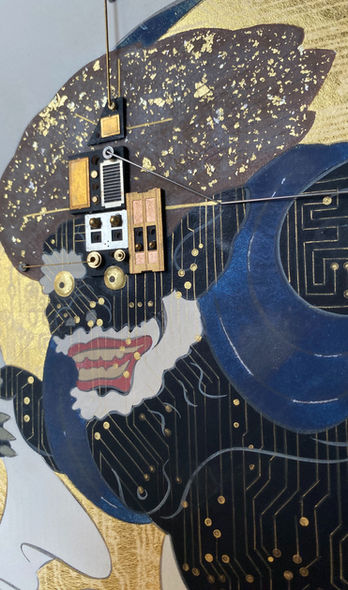
Highlights
New Works Presentations
Toyohiko Nisijima
Wind God and Thunder God
2025
Diptych, original semiconductor base, Washi paper, gold, pigment paintings on wooden panel
35 x 35 cm each panel.

A remarkable futuristic work by Japanese artist Toyohiko Nishijima, Raijin Fujin (The God of Thunder and Wind) pays homage to Tawaraya Sōtatsu’s iconic 17th-century folding screen. Rather than replicating the original, Nishijima reimagines these divine forces of wind and thunder through the symbolic aesthetics of the contemporary digital world.
In traditional mythology, Fujin and Raijin represent the fearsome, untamed powers of nature, forces that evoke awe, terror, and reverence. In Sōtatsu’s rendering, they appear as anthropomorphic agents of chaos and weather: divine figures beyond human control or comprehension. Nishijima, however, recontextualizes these deities within a technological cosmos, transforming them into cybernetic entities (avatars of systemic logic). Their once-organic vitality is now encoded in the logic of the techno-sublime, expressed through algorithms, data flows, and artificial intelligence.
In Raijin Fujin, the gods are not merely re-embodied in technological form; they are subtly subordinated to human cognition. Their power is made visible, mapped, and aestheticized, rendered legible through the very systems that once threatened to overwhelm understanding. Their faces and torsos are partially constructed out of microchip-like components, converting once-mythic power into digital force. Their eyes are haunting and robotic, evoking surveillance or algorithmic vision rather than emotional sentience. Like the circuitry they bear, their visibility suggests clarity, but offers only symbolic legibility, not true comprehension. These technological embellishments signal a crucial conceptual shift: from nature’s overwhelming otherness, once experienced as an external and uncontrollable force, to the human-made enigma of technology. The awe remains, but it is now directed toward systems we ourselves have created.
And yet, these systems remain opaque, not because they resist all analysis, but because their complexity exceeds what can be fully abstracted or mastered through reason alone. Nishijima’s work relocates the experience of the sublime to the heart of human-made infrastructures that are no less vast or overpowering, but no longer entirely "Other." These gods no longer dwell outside us; they are built from our technologies, mirroring our own systems and selves. We are entangled with them. In this space of partial legibility, where knowledge no longer guarantees control, his work evokes a post-dualist dynamic: one in which the subject, though dwarfed by the spectacle, reclaims agency not through rational supremacy, but through embodied attunement, a shared, material entanglement with the forces it confronts.
Nishijima’s vision, then, is not merely an update of myth, but a reflection on how we live within the systems we create, how awe persists not despite technology, but through it, as we navigate its opacity not from above, but from within. Through his work, we see how ancient fears of nature’s wrath have evolved into contemporary ambivalence toward technological scale and complexity. Yet in both cases, it is the human impulse to abstract, interpret, and find meaning that frames the experience. His work reminds us that while the icons of fear may change, our need to measure ourselves against them, and to emerge with a renewed sense of agency, remains a defining gesture of human consciousness.







